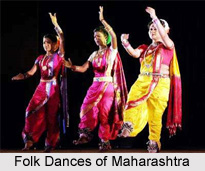 Tamasha is a form of theatre, which came into existence in the early 16th century in Maharashtra, which includes the love songs i.e. `Lavanis` due to which, this folk art, was very popular among the common people. Not only during its inception, but even today Tamasha happen to be one of the most awaited folk performances in the Indian state of Maharashtra. Tamasha includes songs and dance along with the musical instruments like the Dholki drum, `Tuntuni` (a single string instrument), `Manjira` cymbals, `Daf` (a tambourine-like instrument with a single leather surface), `Halgi` (smaller Daf), the metal triangle called `Kade`, the `Lejim` (an instrument with a jangling sound), the Harmonium and `Ghunghroos` (ankle bells). Tamasha is associated and performed with two of the communities of Maharashtra, viz: Kolhati and Mahar.
Tamasha is a form of theatre, which came into existence in the early 16th century in Maharashtra, which includes the love songs i.e. `Lavanis` due to which, this folk art, was very popular among the common people. Not only during its inception, but even today Tamasha happen to be one of the most awaited folk performances in the Indian state of Maharashtra. Tamasha includes songs and dance along with the musical instruments like the Dholki drum, `Tuntuni` (a single string instrument), `Manjira` cymbals, `Daf` (a tambourine-like instrument with a single leather surface), `Halgi` (smaller Daf), the metal triangle called `Kade`, the `Lejim` (an instrument with a jangling sound), the Harmonium and `Ghunghroos` (ankle bells). Tamasha is associated and performed with two of the communities of Maharashtra, viz: Kolhati and Mahar.
History of Tamasha
The history of Tamasha is quite different from the other folk forms in Maharashtra. The interspersed poetry and narrative writing in Tamasha tells us of the existence of many dance and music themes of the Ramayana and the Mahabharata. One can also find a strong influence of the Sanskrit Literature in writing and on creativity of this Marathi folk art. Ram Joshi (1762-1812) is considered as the originator of the Tamasha. He was familiar with the Sanskrit puranas, the recitation and singing of the Kirtaniyas and also with the popular forms of common theatre along the countryside. His association later with Moropant, an outstanding name in contemporary Marathi writing, led to a transformation which resulted in the Lavani singing for the popularization of the Aryas of Moropant. The poet singers in Lavani were known as "Shahirs" had composed many narrative and love songs for Tamasha. So, scholars still believe that Lavani is derived from Tamasha itself.
Besides, the ones stated above, there were two other forms of Tamasha, which is important to mention in the context of the same. One was the ballad singing tradition of the Pawada and the other was the theatrical form known as the Dasavatara (ten incarnations of Lord Vishnu). This form is common to Maharashtra, along with many other parts of India like Karnataka and it also survives in the Goa and the Konkan region. Finally, there was one more form; this was the Gavalana, which have been greatly used by most of the Vaishnavites saint poets of Marathi literature.
 Performance of the Tamasha
Performance of the Tamasha
Tamasha can be performed, anywhere, without the construction of any special stage like the village square, the courtyard of any house, an open ground or even on an artificial stage. The overwhelming performance begins with the entry of the musicians as in the other dance-drama forms. At the beginning two percussionists named the dholkiwala and the Halgiwala enter in the scene. Here, while the dholkiwala provides the basic rhythm by playing the usual metrical cycles on the dholak, the Halgi provides the sharp accents and other piercing sounds, which add up as the musical background of Tamasha. The musical compositions of the Tamasha have a simultaneous use of the Raga and the incorporation of many folk and indigenous melodies. Amongst the Hindustani Ragas used for Tamasha Yaman, Bhairavi, and Pilu are common.
These two performers announce the beginning of the recital loudly accompanied by two more instrumentalists, viz: the manjirawala and the tun-tuna player, who sometimes also make their contribution in singing the lavanis. The entry of the singer held at last and he acquires position in front of the group. There is also the Surtya, the provider of the drone or the tonic who often joins in the singing. After the drumming is over, the main musician enters and takes his position in the group, for an invocation song called the Gana for Lord Ganesha. The Gana follows the Gavalana or the Gaulaniare, which is a Marathi counterpart of the Krishnlila in the Marathi religious literature. It is the one, in which different episodes of the life of Lord Krishna are described, sung and enacted frequently.
Apart from the dance sequences, the movement enters into the Tamasha through considerable acrobatic play, which is executed, by the Natucni (female actress), Songadya and other characters. All this rich fare of elementary ritual, farce, satire, sarcasm, dance and music concludes with something, which is similar to an Aarti. Most of the times, the conclusion is always on a high moral note that the good wins, evil perishes, truth is victorious and falsehood is self-destructive.
The costumes of the Tamasha players, who are called by various names like the Gammat, Phada, are not fixed costumes, but they are the clothes, which depict the different sections of the society in Maharashtra. In short content determined by the nature of their performances and the chiselling of the conventions in the folk forms like the Tamasha gave a new dimension to the theatre art in Maharashtra. Today, Marathi drama and theatre, after evolving for years, now has become an awareness weapon, which can challenge norms and often embraces rebellious issues for the common man. A new, obscenity-free version of Tamasha has evolved nowadays which is known as the Loknatya theatre.